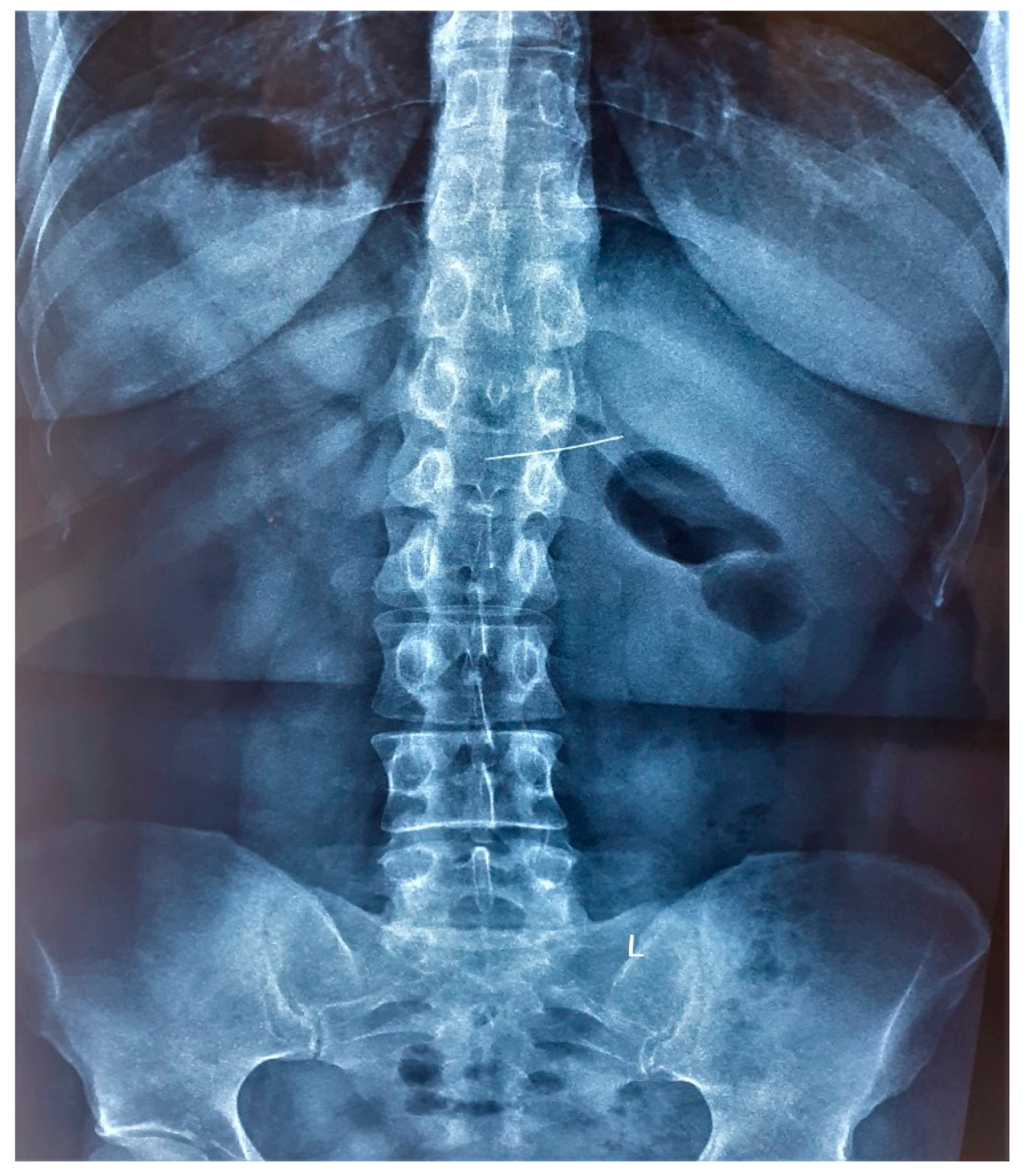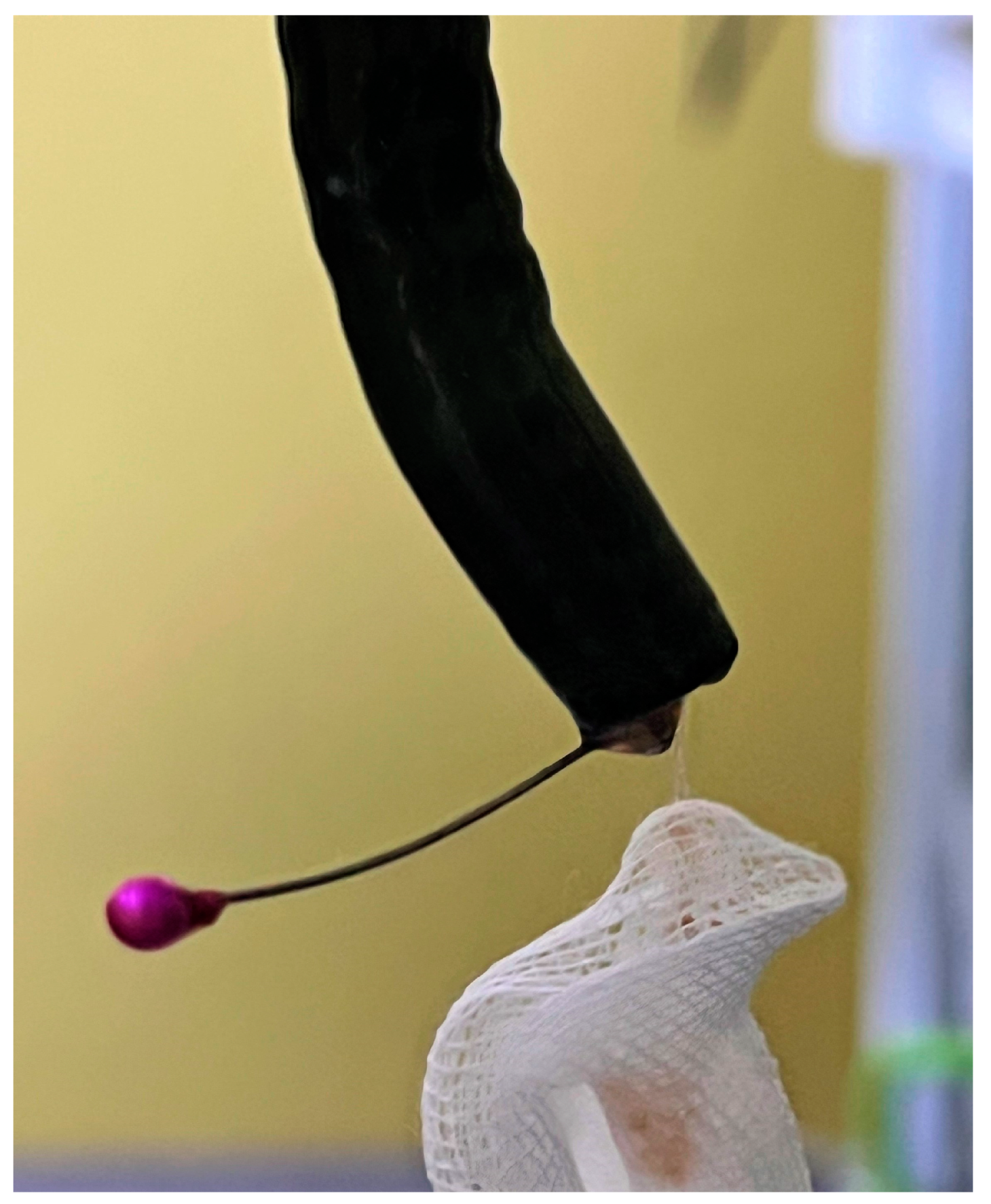Accidental Sewing Pin Ingestion by a Tailor: A Case Report and Literature Review
Abstract
:1. Introduction
2. Case Presentation
3. Discussion
4. Conclusions
Author Contributions
Funding
Institutional Review Board Statement
Informed Consent Statement
Data Availability Statement
Conflicts of Interest
References
- Wang, X.; Su, S.; Chen, Y.; Wang, Z.; Li, Y.; Hou, J.; Zhong, W.; Wang, Y.; Wang, B. The removal of foreign body ingestion in the upper gastrointestinal tract: A retrospective study of 1182 adult cases. Ann. Transl. Med. 2021, 9, 502. [Google Scholar] [CrossRef] [PubMed]
- Feng, S.; Peng, H.; Xie, H.; Bai, Y.; Yin, J. Management of Sharp-Pointed Esophageal Foreign-Body Impaction With Rigid Endoscopy: A Retrospective Study of 130 Adult Patients. Ear Nose Throat J. 2020, 99, 251–258. [Google Scholar] [CrossRef] [PubMed]
- Birk, M.; Bauerfeind, P.; Deprez, P.H.; Häfner, M.; Hartmann, D.; Hassan, C.; Hucl, T.; Lesur, G.; Aabakken, L.; Meining, A. Removal of foreign bodies in the upper gastrointestinal tract in adults: European Society of Gastrointestinal Endoscopy (ESGE) Clinical Guideline. Endoscopy 2016, 48, 489–496. [Google Scholar] [CrossRef]
- Fung, B.M.; Sweetser, S.; Wong Kee Song, L.M.; Tabibian, J.H. Foreign object ingestion and esophageal food impaction: An update and review on endoscopic management. World J. Gastrointest. Endosc. 2019, 11, 174–192. [Google Scholar] [CrossRef]
- Bezabih, Y.S.; Getu, M.E. Spontaneous passage of accidentally ingested metallic nail in an adult: A case report. Int. J. Surg. Case Rep. 2022, 92, 106865. [Google Scholar] [CrossRef]
- Li, Z.S.; Sun, Z.X.; Zou, D.W.; Xu, G.M.; Wu, R.P.; Liao, Z. Endoscopic management of foreign bodies in the upper-GI tract: Experience with 1088 cases in China. Gastrointest. Endosc. 2006, 64, 485–492. [Google Scholar] [CrossRef] [PubMed]
- Chen, Q.; Chu, H.; Tong, T.; Tao, Y.; Zhou, L.; Chen, J.; Liu, Y.; Peng, L. Predictive factors for complications associated with penetrated fish bones outside the upper gastrointestinal tract. Eur. Arch. Otorhinolaryngol. 2019, 276, 185–191. [Google Scholar] [CrossRef] [PubMed]
- Chen, B.; Cyr, D.G.; Hales, B.F. Role of apoptosis in mediating phosphoramide mustard-induced rat embryo malformations in vitro. Teratology 1994, 50, 1–12. [Google Scholar] [CrossRef] [PubMed]
- Geng, C.; Li, X.; Luo, R.; Cai, L.; Lei, X.; Wang, C. Endoscopic management of foreign bodies in the upper gastrointestinal tract: A retrospective study of 1294 cases. Scand J. Gastroenterol. 2017, 52, 1286–1291. [Google Scholar] [CrossRef]
- Boo, S.J.; Kim, H.U. Esophageal Foreign Body: Treatment and Complications. Korean J. Gastroenterol. 2018, 72, 1–5. [Google Scholar] [CrossRef] [PubMed]
- Jaan, A.; Mulita, F. Gastrointestinal Foreign Body; StatPearls Publishing LLC: Treasure Island, FL, USA, 2023. [Google Scholar]
- Zhang, S.; Cui, Y.; Gong, X.; Gu, F.; Chen, M.; Zhong, B. Endoscopic management of foreign bodies in the upper gastrointestinal tract in South China: A retrospective study of 561 cases. Dig. Dis. Sci. 2010, 55, 1305–1312. [Google Scholar] [CrossRef]
- Yoo, D.R.; Im, C.B.; Jun, B.G.; Seo, H.I.; Park, J.K.; Lee, S.J.; Han, K.H.; Kim, Y.D.; Jeong, W.J.; Cheon, G.J.; et al. Clinical outcomes of endoscopic removal of foreign bodies from the upper gastrointestinal tract. BMC Gastroenterol. 2021, 21, 385. [Google Scholar] [CrossRef]
- Boumarah, D.N.; Binkhamis, L.S.; AlDuhileb, M. Foreign body ingestion: Is intervention always a necessity? Ann. Med. Surg. 2022, 84, 104944. [Google Scholar] [CrossRef]
- Mosca, S.; Manes, G.; Martino, R.; Amitrano, L.; Bottino, V.; Bove, A.; Camera, A.; De Nucci, C.; Di Costanzo, G.; Guardascione, M.; et al. Endoscopic management of foreign bodies in the upper gastrointestinal tract: Report on a series of 414 adult patients. Endoscopy 2001, 33, 692–696. [Google Scholar] [CrossRef]
- Shishido, T.; Oka, S.; Tanaka, S.; Aoyama, T.; Watari, I.; Imagawa, H.; Yoshida, S.; Hiyama, T.; Chayama, K. Removal of a sewing needle penetrating the wall of the third portion of the duodenum by double-balloon endoscopy. Clin. J. Gastroenterol. 2012, 5, 79–81. [Google Scholar] [CrossRef] [PubMed]
- Costa, S.; Gonçalves, R.; Rolanda, C. Endoscopic removal of multiple sharp gastro-duodenal foreign bodies. Rev. Esp. Enferm. Dig. 2017, 109, 144–145. [Google Scholar] [PubMed]
- Liu, Q.; Liu, F.; Xie, H.; Dong, J.; Chen, H.; Yao, L. Emergency Removal of Ingested Foreign Bodies in 586 Adults at a Single Hospital in China According to the European Society of Gastrointestinal Endoscopy (ESGE) Recommendations: A 10-Year Retrospective Study. Med. Sci. Monit. 2022, 28, e936463. [Google Scholar] [CrossRef]
- Yu, M.; Li, K.; Zhou, S.; Wang, H.; Le, M.; Li, C.; Liu, D.; Tan, Y. Endoscopic Removal of Sharp-Pointed Foreign Bodies with Both Sides Embedded into the Duodenal Wall in Adults: A Retrospective Cohort Study. Int. J. Gen. Med. 2021, 14, 9361–9369. [Google Scholar] [CrossRef]
- Dal, F.; Hatipoğlu, E.; Teksöz, S.; Ertem, M. Foreign body: A sewing needle migrating from the gastrointestinal tract to pancreas. Turk. J. Surg. 2018, 34, 256–258. [Google Scholar] [CrossRef] [PubMed]
- Bekkerman, M.; Sachdev, A.H.; Andrade, J.; Twersky, Y.; Iqbal, S. Endoscopic Management of Foreign Bodies in the Gastrointestinal Tract: A Review of the Literature. Gastroenterol. Res. Pract. 2016, 2016, 8520767. [Google Scholar] [CrossRef]
- Cheng He, R.; Nobel, T.; Greenstein, A.J. A case report of foreign body appendicitis caused by tongue piercing ingestion. Int. J. Surg. Case Rep. 2021, 81, 105808. [Google Scholar] [CrossRef] [PubMed]
- Jutte, E.; Cense, H. Liver abscess due to sewing needle perforation. Sci. World J. 2010, 10, 1532–1534. [Google Scholar] [CrossRef] [PubMed]
- Ikenberry, S.O.; Jue, T.L.; Anderson, M.A.; Appalaneni, V.; Banerjee, S.; Ben-Menachem, T.; Decker, G.A.; Fanelli, R.D.; Fisher, L.R.; Fukami, N.; et al. Management of ingested foreign bodies and food impactions. Gastrointest. Endosc. 2011, 73, 1085–1091. [Google Scholar] [CrossRef] [PubMed]
- Wu, W.T.; Chiu, C.T.; Kuo, C.J.; Lin, C.J.; Chu, Y.Y.; Tsou, Y.K.; Su, M.Y. Endoscopic management of suspected esophageal foreign body in adults. Dis. Esophagus. 2011, 24, 131–137. [Google Scholar] [CrossRef]
- Sugawa, C.; Ono, H.; Taleb, M.; Lucas, C.E. Endoscopic management of foreign bodies in the upper gastrointestinal tract: A review. World J. Gastrointest. Endosc. 2014, 6, 475–481. [Google Scholar] [CrossRef]
- Siti Soraya, A.R. Ingested pins—A potential hazard for hijabis: A case report. Med. J. Malays. 2020, 75, 78–79. [Google Scholar]
- Yogev, D.; Mahameed, F.; Gileles-Hillel, A.; Millman, P.; Davidovics, Z.; Hashavya, S.; Rekhtman, D.; Wilschanski, M.; Berkun, Y.; Slae, M. Hijab Pin Ingestions. Pediatrics 2020, 145, e20193472. [Google Scholar] [CrossRef]
- Zong, Y.; Zhao, H.; Sun, C.; Ji, M.; Wu, Y.; Zhang, S.; Wang, Y. Differences between intentional and accidental ingestion of foreign body in China. BMC Gastroenterol. 2020, 20, 90. [Google Scholar] [CrossRef]
- Ha, N.R.; Lee, H.L.; Yoon, J.H.; Jo, S.C.; Lee, K.N.; Shim, S.G.; Lee, O.Y.; Yoon, B.C.; Choi, H.S.; Hahm, J.S.; et al. A case of an ingested sewing needle in the appendix. Gastrointest. Endosc. 2009, 70, 1244–1245. [Google Scholar] [CrossRef]
- Espin, D.S.; Tufiño, J.F.; Cevallos, J.M.; Zumárraga, F.; Orozco, V.E.; Proaño, E.J.; Molina, G.A. A needle in the colon, the risk of ingested foreign objects: A case report. J. Surg. Case Rep. 2021, 2021, rjab455. [Google Scholar] [CrossRef]



Disclaimer/Publisher’s Note: The statements, opinions and data contained in all publications are solely those of the individual author(s) and contributor(s) and not of MDPI and/or the editor(s). MDPI and/or the editor(s) disclaim responsibility for any injury to people or property resulting from any ideas, methods, instructions or products referred to in the content. |
© 2023 by the authors. Licensee MDPI, Basel, Switzerland. This article is an open access article distributed under the terms and conditions of the Creative Commons Attribution (CC BY) license (https://creativecommons.org/licenses/by/4.0/).
Share and Cite
Stojkovic, S.; Bjelakovic, M.; Stojkovic Lalosevic, M.; Stulic, M.; Pejic, N.; Radivojevic, N.; Stojkovic, N.; Martinov Nestorov, J.; Culafic, D. Accidental Sewing Pin Ingestion by a Tailor: A Case Report and Literature Review. Medicina 2023, 59, 1566. https://doi.org/10.3390/medicina59091566
Stojkovic S, Bjelakovic M, Stojkovic Lalosevic M, Stulic M, Pejic N, Radivojevic N, Stojkovic N, Martinov Nestorov J, Culafic D. Accidental Sewing Pin Ingestion by a Tailor: A Case Report and Literature Review. Medicina. 2023; 59(9):1566. https://doi.org/10.3390/medicina59091566
Chicago/Turabian StyleStojkovic, Stefan, Milica Bjelakovic, Milica Stojkovic Lalosevic, Milos Stulic, Nina Pejic, Nemanja Radivojevic, Nemanja Stojkovic, Jelena Martinov Nestorov, and Djordje Culafic. 2023. "Accidental Sewing Pin Ingestion by a Tailor: A Case Report and Literature Review" Medicina 59, no. 9: 1566. https://doi.org/10.3390/medicina59091566




